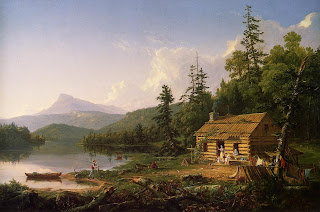What was village life like in Vermont after settlement? What did they do for food, clothing, and shelter? How and where did they travel? The James Whitelaw maps of 1796 and 1810 provide a window into that world. These maps show the major buildings in each Vermont community.
Begin by providing your students with a visual image of life at settlement. One possible image is
Thomas Cole’s painting, A Home in the Woods. While it is romanticized, it still provides the types of details that students need to “enter” into the Whitelaw maps. Use visual thinking strategies to gather details students see in the picture. Categorize those details into “food,” “clothing,” and “shelter.”
Now find your own town on the Whitelaw map and have students do the following:
Check off any of the following that appear on the map–the key is at the top of this post and is also located on the bottom right of the map. Hopefully they will have some questions about these terms and will want to do a bit of research.
_________ Meeting Houses _________ Grist Mills _________ Swamps
_________ Forts _________ Saw Mills _________ Dwelling Houses
_________ Falls _________ Fulling Mills _________ Grammar Schools
_________ Ferries _________ Iron Works
_________ Bridges _________ Mountains
Now answer these questions:
Where are the churches and other large public buildings located?
Where are the mills and factories located?
What can you see on this map that would help settlers in your town make their cloths?
What can you see on this map that would help settlers in your town build their homes?
What can you see on this map that would help settlers in your town bake their bread?
Where do the roads go?
What might you conclude about your town from this map?
What questions do you now have?


